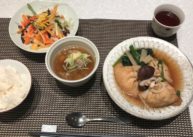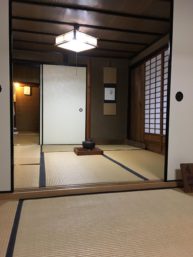For my CIP activity, I decided to take the path less traveled (literally) and hike up a large hill near Kinkakuji each week to partake in traditional zazen in a small Buddhist temple, Fumonken. At these meetings, which were entirely in Japanese and one-on-one, my priest and I would first have a lesson, of sorts. In this brief lesson, my priest would introduce a central zen concept (for example, the first week we discussed muga (無我) and it’s relation to Japanese zen) which featured both philosophy and philology, as he frequently would connect the related kanji to both Buddhist legends and to modern Japanese language and I would desperately try and follow along. These lessons were only about a half-hour long, sadly, but were always riveting; for someone like me who loves both the history of language and philosophy, I never lacked for interesting subject matter in these discussions. We would also always have sweets and tea during our discussions, relaxing on small cushions and both donning Buddhist robes.
The second part of the experience was then proper zazen meditation. I would first remove the paper screens from the meditation room, to clear a view to the rock garden and open the area up to fresh air, and then we would sit and meditate for about a half an hour. At first this was agonizingly painful for my legs, but with repetition the pain has progressed from “bear mauling” levels to more like “light gunshot wound”, which I would call a plus. Certainly the experience of meditating in itself has been beneficial for me, allowing me a quiet place to first worry about things, then worry that I’m ruining my meditation by worrying, and finally overcoming both and finally shutting my inner dialogue up. In the Rinzai school of Buddhist zen that I am practicing (and is, incidentally, the most rigorous type! Joy!) when meditating one must always keep the eyes open; this is 1. So you don’t fall asleep and 2. If your mind is truly in no place, looking ahead should be no different than eyes closed, as you should be unable to “see” anything.
This experience has taught me a lot of humility. It has taught me a lot about leg pain. It has taught me a lot about how complicated kanji history can be. I think most significantly, I have gained some intriguing insights into how Buddhism and the modern mindset cannot coexist. You have to pursue one or the other; both are inherently toxic to the other. Learning how this dichotomy has played out here in Japan, with such a deep tradition of Buddhism and now such a voracious consumer culture has been fascinating, not least because I am learning it from my priest who is an ex-salaryman. I am glad I chose to pursue a more ephemeral CIP, as I think personally this experience has been more helpful to my ongoing construction of my own identity and growth of my spirit than anything else could have been.
In terms of observations, the temple I go to is quite small and cozy. It is located near Kinkakuji, high up on a hill, and seems to receive very little traffic. I have seen several other adherents stop by, but usually they are working for a room for a night or two. The temple is actually my priest’s house, and so I have gotten a little look at the orderly (if cramped) lifestyle of the ordinary Japanese. As for my priest himself, he is a warm, genial ex-salaryman who decided the priestly life was far more interesting for him, and so married a French woman and became a Buddhist priest. I can’t attest to their relationship much since I rarely ever see his wife, but they seem to handle the language barrier and the whole issue of his priesthood quite well.
Finally, in terms of feelings, the greatest feeling I have with zazen is relief. Relief to be away from my phone, job applications, emails, commitments; even time itself seems to bend to the overwhelming silence. Having no prior experience with meditation, that aspect I also find to be refreshing, despite the sometimes difficult leg postures. I am glad to have chosen such a radically project, I think, as it is now coming in handy both in terms of resume-building (because, of course, the hustle never stops) and in finding inner peace.


